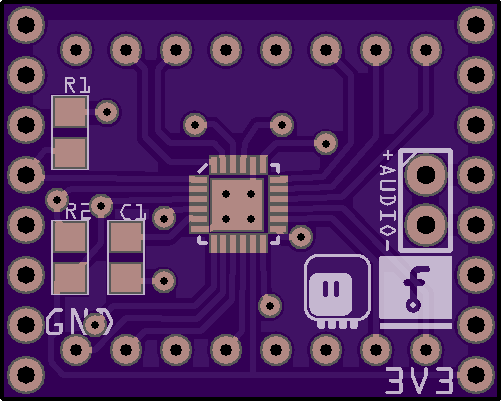While ordering the different colors for the mini 8x8 LED matrices, I couldn't help but notice the bi-color and RGB matrices in the same size. The RGB one would be a bit difficult to route for me on a two-sided PCB, but I decided to give the bi-color one a try and ordered it. It should be super-easy to route, because the row pins are actually in order on both sides, and in the middle are the common column pins. The only problem is that I would need to use the 28-pin HT16K33 chip, and it would need to sit across the middle column -- but with good flat wire cutters that seemed doable.
Recently the matrices arrived, and also the PCB from OSHPark that I ordered to test the bi-color matrix:

As you can see, I didn't care about the order of rows and columns, and just routed them in random order -- assuming I can fix that in software later on. Unfortunately, the matrix didn't work. A closer inspection revealed that I got the common-anode matrix, whereas the HT16K33 can only handle the common cathode ones. Bummer. I ordered the correct, common-cathode matrices then.
But now I have a bunch of matrices I can't drive easily, and this feeling that I should really do something with them. I looked for a chip that could handle them, but in vain. I posted a question to the stack, and updated it with what I found. And then, @Jeremy Gilbert suggested a family of chips that I forgot about.
You see, there are those charlieplexed LED FeatherWings that Adafruit has, with a very cool IS31FL3731 chip. I even wrote a MicroPython library for driving them once! But I didn't realize that there is a whole family of those chips, and they are not only for charlieplexed displays, also for regular matrices. And they are much more modern than the venerable HT16K33, and have cool features, like the ability to set the brightness of every pixel individually, built-in blinking and animations, and even changing the brightness according to audio input!
So I decided to try and also make a couple of shields with those. We will see how well that works, for a start I ordered a board for the simplest IS31FL3728 chip:
 It will probably be a bit tricky to solder, being in a QFN package, but nothing that I didn't manage before. I will keep you updated.
It will probably be a bit tricky to solder, being in a QFN package, but nothing that I didn't manage before. I will keep you updated.
 deʃhipu
deʃhipu
Discussions
Become a Hackaday.io Member
Create an account to leave a comment. Already have an account? Log In.